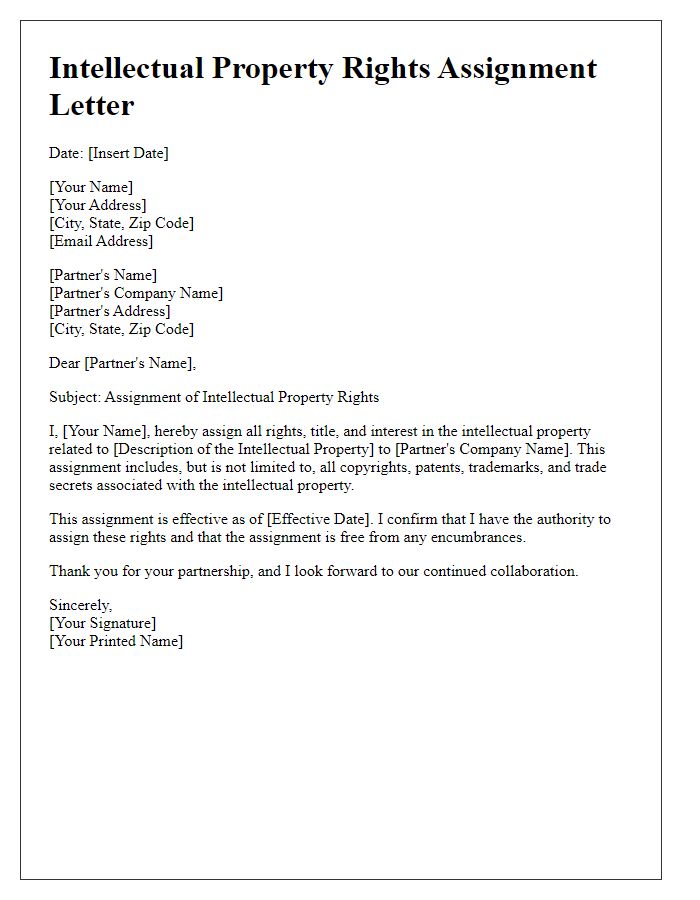Are you ready to dive into the often complex world of intellectual property rights? In this article, we'll unravel the intricacies of IP, exploring its significance and how it protects your creative endeavors. From patents to trademarks, understanding these rights is essential for anyone looking to safeguard their innovations. So, if you're curious about how to effectively navigate this landscape, stay tuned for more insights!

Parties Involved
The parties involved in intellectual property rights assignments typically include the assignor, often the creator or inventor (individual or entity), who holds the original rights to the intellectual property, such as patents, trademarks, or copyrights. The assignee, which may be a company or an individual, receives the rights and becomes the new holder of the intellectual property. For instance, in a technology assignment, a software developer may assign a patent for a new algorithm to a tech company, aiming to commercialize the invention. Legal representatives from both parties frequently participate, ensuring compliance with laws and regulations governing intellectual property, such as the United States Patent and Trademark Office (USPTO) guidelines. Additionally, specific terms like duration of rights, territory (for example, rights may be assigned within the United States or internationally), and any compensation or royalties often play crucial roles in the assignment agreement.
Description of Intellectual Property
Intellectual property (IP) encompasses legal rights that protect creations of the mind, including inventions, literary and artistic works, symbols, names, and images used in commerce. Various types of intellectual property exist, such as patents, copyrights, trademarks, and trade secrets, with each serving specific protective functions. For instance, patents protect new inventions and grant exclusive rights for a period of 20 years, while copyrights safeguard original works of authorship, ranging from literature to music, and typically last for the life of the author plus 70 years. Trademarks, including brand logos and identifiers, help consumers distinguish between products and services in the marketplace, with protections that can endure indefinitely as long as they are used in commerce. Trade secrets, such as formulas, practices, or processes, offer protection against unauthorized use, provided they remain confidential. Understanding these forms of intellectual property is vital for protecting innovative ideas and maintaining competitive advantages in dynamic markets.
Scope of Assignment
The scope of the intellectual property rights assignment encompasses a comprehensive analysis of various types of intellectual property, including patents, trademarks, copyrights, and trade secrets. This exploration will focus on the legal frameworks governing these rights in key jurisdictions such as the United States, European Union, and China, highlighting significant international treaties like the Paris Convention and the TRIPS Agreement. Specific case studies will illustrate landmark judicial decisions that shaped current practices, including the Apple v. Samsung patent dispute, which underscores the complexities of patent law in the technology sector. Additionally, the assignment will assess the impact of digital technology on copyright law, particularly concerning software and online content. Statistical data on intellectual property litigation trends and infringement cases will provide deeper insights into enforcement challenges. Overall, the assignment aims to offer a thorough understanding of how intellectual property rights influence innovation, business strategy, and consumer protection in the global economy.
Duration and Termination Clauses
Duration and termination clauses in intellectual property rights agreements define the lifespan of the rights granted and the conditions under which the agreement may be ended. These clauses typically specify a fixed term, often lasting several years, during which the intellectual property (such as patents, trademarks, or copyrights) remains protected and enforceable. Moreover, they outline specific conditions for early termination, including breach of contract, mutual consent, or failure to uphold licensing obligations. For instance, if a party fails to pay licensing fees or complies with established maintenance requirements, the rights may revert to the original owner. Additionally, renewal options may be included, allowing for the extension of protection under agreed terms, providing a crucial mechanism for ongoing innovation and safeguarding intellectual assets.
Governing Law and Jurisdiction
Governing law plays a crucial role in intellectual property rights, determining how legal disputes are resolved. Typically, this law is influenced by jurisdictions such as the United States (federal and state laws) or the European Union directives that protect intellectual property (IP) across member states. Jurisdiction refers to the legal authority a court possesses to hear cases, which may vary based on the geographical location of the parties involved and the nature of the IP issues. For instance, trademark cases can invoke both national laws and international treaties such as the Paris Convention. In contrast, copyright disputes may focus on specific territorial laws, especially in countries with unique copyright frameworks like Japan, which has its distinct set of protections under the Copyright Act. Understanding the governing laws and jurisdiction is essential for effectively navigating IP assignments, ensuring compliance, and enforcing rights in different legal landscapes.
Letter Template For Intellectual Property Rights Assignment Samples
Letter template of intellectual property rights assignment for inventions

Letter template of intellectual property rights assignment for trademarks

Letter template of intellectual property rights assignment to a business partner

Letter template of intellectual property rights assignment for research projects










Comments